|
Crystal Cave
of Giants in Mexico
from
Crystalinks Website
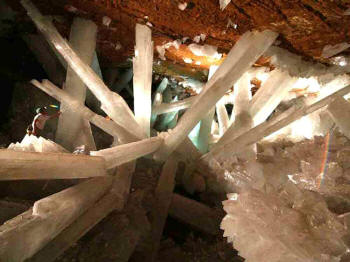
The Naica Mine of Chihuahua, Mexico, is
a working mine that is known for its extraordinary crystals. Naica
is a lead, zinc and silver mine in which large voids have been
found, containing crystals of selenite (gypsum) as large as 4 feet
in diameter and 50 feet long. The chamber holding these crystals is
known as the Crystal Cave of Giants, and is approximately 1000 feet
down in the limestone host rock of the mine. The crystals were
formed by hydrothermal fluids emanating from the magma chambers
below. The cavern was discovered while the miners were drilling
through the Naica fault, which they were worried would flood the
mine. The Cave of Swords is another chamber in the Naica Mine,
containing similar large crystals.
The Naica mine was first discovered by early prospectors in 1794
south of Chihuahua City. They struck a vein of silver at the base of
a range of hills called Naica by the Tarahumara Indians. The origin
in the Tarahumara language seems to mean "a shady place". Perhaps
here in the small canyon there was a grove of trees tucked away by a
small canyon spring.
From that discovery, until around 1900, the primary interest was
silver and gold. Around 1900 large-scale mining began as zinc and
lead became more valuable.
During the Mexican Revolution the mine was producing a great deal of
wealth. Revolutionary troops entered the town and demanded money
from the owners. One of them was assassinated when he refused to
pay, causing the mine to shut down from 1911 to 1922.
Just before the mine was closed, the famous Cave of Swords was
discovered at a depth of 400 feet. Due to the incredible crystals,
it was decided to try to preserve this cave. While many of the
crystals have been collected, this is still a fascinating cave to
visit. In one part there are so many crystals on one of the walls,
they appear to be like an underwater reef moving in a gentle
undulating motion in an ocean current.
In April 2000, brothers Juan and Pedro Sanchez were drilling a new
tunnel when they made a truly spectacular discovery. While Naica
miners are accustomed to finding crystals, Juan and Pedro were
absolutely amazed by the cavern that they found. The brothers
immediately informed the engineer in charge, Roberto Gonzalez. Ing.
Gonzalez realized that they had discovered a natural treasure and
quickly rerouted the tunnel. During this phase some damage was done
as several miners tried to remove pieces of the mega-crystals, so
the mining company soon installed an iron door to protect the find.
Later, one of the workers, with the intention of stealing crystals,
managed to get in through a narrow hole. He tried to take some
plastic bags filled with fresh air inside, but the strategy didn't
work. He lost consciousness and later was found thoroughly baked.
When entering the cave our group is issued helmets, lanterns, rubber
boots, and gloves. One must then be driven by truck into the main
mining tunnel called Rampa Sn. Francisco. While the vertical drop is
approximately 1000 feet, the drive is almost a half mile long. The
heat steadily increases and women have been observed to begin
"glowing". The truck stops in front of a concrete wall with a steel
door. The intense heat can prevent brain functioning.
At the end of the tunnel there are three or four steps into the
aperture of the cavern itself. It is in this short tunnel. In this
short distance the temperature and humidity goes from being
uncomfortably warm to literally a blast furnace.
Momentarily, the penetrating heat is forgotten as the crystals pop
into view on the other side of the "Eye of the Queen". The entire
panorama is now lighted and the cavern has a depth and impressive
cathedral-like appearance that was not visible on earlier trips with
just our headlamps.
When inside the great cathedral of crystals, the pressure of intense
heat create a gamut of emotions and perhaps hallucinations. One can
only remain for a short period of time.
Geologists report that these natural crystal formations are
incredibly complex, yet so simple. They have a magical or
metaphysical personality independent of their chemical structures.
There is a magma chamber two to three miles below the mountain and
that heat from this compressed lava travels through the faults up
into the area of the mine. Super heated fluids carry the minerals
the miners are seeking as well as form the crystals. The mine is
ventilated; otherwise, it could not be worked. Some parts, however,
are not air-conditioned, such as the Cave of the Crystals, and there
you feel the heat from the magma deep below. The fluids travel along
the Naica fault, enter voids in the bedrock, and then form entirely
natural structures that are not easily explained scientifically.
In April 2000, the mining company became confident that the water
table on the other side of the fault had been lowered sufficiently
to drill.
When they did this, it is almost as if a magical veil of reality was
breached and an entirely new world was discovered. Two caverns
filled with the Earth's largest crystals were immediately revealed.
More discoveries are expected to be made in this magical kingdom of
intense natural beauty.
Selenite, the gypsum crystal, named after the Greek goddess of the
moon, Selene, due to its soft white light, is said to have many
metaphysical and healing benefits. Selenite powder has been used
cosmetically for thousands of years to enhance one's natural beauty.
It is believed that this crystal assists with mental focus, growth,
luck, immunity, and soothes the emotions.
Back to Contents
Giant Crystal Cave's Mystery
Solved National Geographic
by Stefan Lovgren
for National Geographic News
April 7, 2007
from
NationalGeographic Website
It's "the Sistine Chapel of crystals," says Juan Manuel García-
Ruiz. The geologist announced this week that he and a team of
researchers have unlocked the mystery of just how the minerals in
Mexico's Cueva de los Cristales (Cave of Crystals) achieved their
monumental forms.
Buried a thousand feet (300 meters)
below Naica mountain in the Chihuahuan Desert, the cave was
discovered by two miners excavating a new tunnel for the Industrias
Peñoles company in 2000. The cave contains some of the largest
natural crystals ever found: translucent gypsum beams measuring up
to 36 feet (11 meters) long and weighing up to 55 tons.
"It's a natural marvel," said García-Ruiz,
of the University of Granada in Spain.
To learn how the crystals grew to such
gigantic sizes, García-Ruiz studied tiny pockets of fluid trapped
inside. The crystals, he said, thrived because they were submerged
in mineral-rich water with a very narrow, stable temperature
range—around 136 degrees Fahrenheit (58 degrees Celsius). At this
temperature the mineral anhydrite, which was abundant in the water,
dissolved into gypsum, a soft mineral that can take the form of the
crystals in the Naica cave.
The new findings appear in the April issue of the journal Geology.
Volcanic Activity
The mining complex in Naica contains some of the world's largest
deposits of silver, zinc, and lead. In 1910 miners discovered
another spectacular cavern beneath Naica. Its walls studded with
crystal "daggers," the Cave of Swords is closer to the surface, at a
depth of nearly 400 feet (120 meters).
While there are more crystals in the upper cave, they are far
smaller, typically about a yard (a meter) long.
Nearly the Size of a Basketball Court
The Cave of Crystals is a
horseshoe-shaped cavity in limestone rock about 30 feet (10 meters)
wide and 90 feet (30 meters) long. Its floor is covered in
crystalline, perfectly faceted blocks. The huge crystal beams jut
out from both the blocks and the floor.
"There is no other place on the
planet where the mineral world reveals itself in such beauty,"
García-Ruiz said.
Volcanic activity that began about 26
million years ago created Naica mountain and filled it with
high-temperature anhydrite, which is the anhydrous—lacking
water—form of gypsum. Anhydrite is stable above 136 degrees
Fahrenheit (58 degrees Celsius). Below that temperature gypsum is
the stable form.
When magma underneath the mountain cooled and the temperature
dropped below 58 degrees Celsius, the anhydrite began to dissolve.
The anhydrite slowly enriched the waters with sulfate and calcium
molecules, which for millions of years have been deposited in the
caves in the form of huge selenite gypsum crystals.
"There is no limit to the size a
crystal can reach," García-Ruiz said.
But, he said, for the Cave of Crystals
to have grown such gigantic crystals, it must have been kept just
below the anhydrite-gypsum transition temperature for many hundreds
of thousands of years.
In the upper cave, by contrast, this transition temperature may have
fallen much more rapidly, leading to the formation of smaller
crystals.
To Reflood or Not to Reflood
While the chance of this set
of conditions occurring on other places in the world is remote,
García-Ruiz expects that there are other caves and caverns at Naica
containing similarly large crystals.
"The caves containing larger
crystals will be located in deeper levels with temperatures
closer to, but no higher than, 58 degrees Celsius," he said.
He has recommended to the mining company
that the caves should be preserved. The only reason humans can get
into the caves today, however, is because the mining company's
pumping operations keep them clear of water. If the pumping is
stopped, the caves will again be submerged and the crystals will
start growing again, García-Ruiz said.
So what happens if—or when—the mine is closed?
"That's an interesting question,"
García-Ruiz said.
"Should we continue to pump water to
keep the cave available so future generations may admire the
crystals? Or should we stop pumping and return the scenario to
the natural origin, allowing the crystals to regrow?"
Back to Contents
Giant Crystals Enjoyed Perfection
April 6, 2007
from
BBCNews Website
With lengths over 11m, the giant gypsum crystals found in Mexico's
Cueva de los Cristales are a great natural wonder
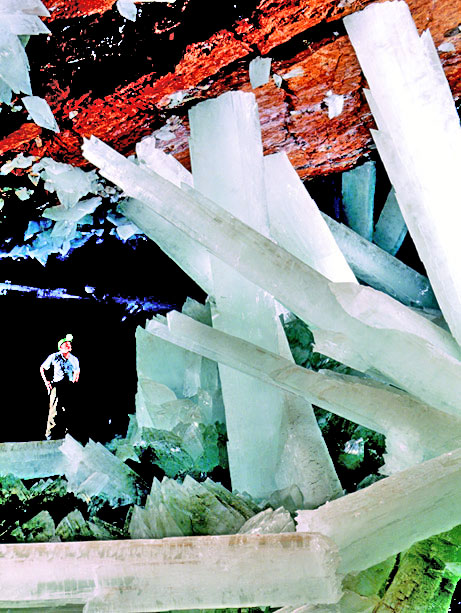
The cave was discovered in 2000
Now, a Spanish-Mexican team thinks it
can explain how these marvels acquired their immense form. The
scientists studied tiny pockets of fluid trapped in the crystals and
conducted back-up lab experiments. They report in the journal
Geology that the solution from which the crystals grew must have
been kept in a very narrow, stable temperature range.
The researchers' analysis leads them to believe there are other
dramatic caves waiting to be discovered in the Naica mine complex
south-east of Chihuahua city.
"If the theory we propose for the
'genetic' mechanisms of the crystals is right, then I would not
be surprised if miners find more of these caves in the next few
years," Juan Manuel Garcia-Ruiz, from the University of Granada,
Spain, told BBC News.
Bigger than 'swords'
Already two remarkable caves
are known at Naica, which has yielded some of the world's most
significant deposits of silver and lead. The 120m-deep Cueva de las
Espadas (Cave of Swords), discovered in 1912, is named for its
meter-long
shafts of gypsum (a calcium sulphate mineral that incorporates water
molecules into its chemical formula). And although individually
there are fewer crystals in the 290m-deep Cueva de los Cristales,
its beams are considerably bigger.
Professor Garcia-Ruiz and colleagues believe they can now show how
these differences emerged. The team studied tiny fluid samples
embedded inside the crystals themselves. These watery inclusions
record tell-tale chemical details of the saline and temperature
conditions of the saturated solution from which the mammoth
structures developed.
'Perfect conditions'
Both caves owe their origin to the volcanism which laid down the
metal sulphides - the ores - that have proved so valuable. Copious
amounts of calcium sulphate would also have been created towards the
end of this mineralization process more than 20 million years ago -
but in the hot fluids that infused the cracks and cavities in the
rock, this calcium sulphate would have taken the form of anhydrite.
Anhydrite has the same chemical formula as gypsum, except that it
excludes water. Only as the magma chamber deep under the Naica
mountain cooled did the hot fluids above start to fall to a
temperature at which anhydrite could switch to gypsum.
Professor Garcia-Ruiz and colleagues say their studies indicate that
the deeper of the two caves - Cueva de los Cristales - must have
been kept just below the transition temperature for many hundreds of
thousands of years.
"The conditions were perfect. By
maintaining the temperature just below 58 degrees for a very
long time you get a few, very big crystals," said Professor
Garcia-Ruiz.
"You can see that many areas on the cave's walls are empty; they
have no crystals. The walls are red because of the iron oxide.
The reason we know this happened for many years is because we
studied the fluid inclusions inside the crystals."
It is likely the upper cave - Cueva de
las Espadas - fell below the transition temperature much more
rapidly and consequently grew many, smaller crystals.
Heritage future?
The particular crystalline form taken by the gypsum is selenite
which is known for its translucency. Their future will be dependent
on the fate of the mine. At the moment, access is restricted to
prevent damage to the soft crystals. And humans can only get in the
caves at all because of the continuous pumping operations that keep
them clear of water.
If, when Naica's ores are no longer viable, the mine is closed and
the pumping is stopped, then the caves will be submerged - and the
crystals will start growing again.
"I've recommended to the mining
company that they try to preserve them and I would like to see
Unesco get involved," explained Professor Garcia-Ruiz.
"Later on we should decide whether to keep them available for
people to visit and enjoy, or let the natural scenario return."
Back to Contents
Largest
Crystals Found in Mexico
Discovery News
February 8, 2001
from
TheCrystalPortal Website
The largest natural crystals on Earth have been discovered in two
caves within a silver and zinc mine near Naica, in Chihuahua,
Mexico, according to mine officials. Reaching lengths of over 20
feet, the clear, faceted crystals are composed of selenite, a
crystalline form of the mineral gypsum.
"Walking into either of these caves
is like stepping into a gigantic geode," said Richard D. Fisher,
an American consultant with the mining company to develop the
discoveries as tourist attractions.
Fisher said that most people can endure
only a few minutes in the caves due to their high temperatures. The
smaller of the two, which is about the size of two-bedroom
apartment, is 100 Fahrenheit. The large chamber, which Fisher
describes as the size of a Cathedral, is 150 F. Both are located
approximately 1200 feet below the surface. The mining company plans
to air-condition the caves before opening them to the public next
year, Fisher said. He adds that reducing the heat gradually will not
harm the crystals.
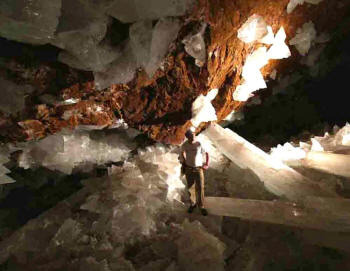
The largest previously known crystals
were found in the nearby "Cave of the Swords", part of the same mine
system. Some of these are now on display at the Smithsonian
Institution. The local government and mine owners hope to avoid
removing any of the new discoveries for museum displays or private
collections, Fisher said.
While the mine company is currently
limiting visitation of the caves to scientific experts, mineral
hunters have destroyed locks and broken into the chambers twice
since they were first opened by mining equipment last April. One man
was killed when he attempted to chop out a gigantic crystal that
fell from the ceiling and crushed him, according to Fisher.
"We need more onsite protection of
mine caves," said geologist Carol A. Hill, co-author of the book
Cave Minerals of the World, who calls the new discoveries "by
far the largest selenite crystals I have ever heard of."
Hill applauds the tourism plan.
"Without it, the mining company
would probably destroy the caves. Museums have enough crystals,"
she said. "It's important to preserve discoveries like this
where they occur."
Fisher and mine officials will display
photographs and small samples of crystals from the new cave at the
Tuscon Gem & Mineral Show in Arizona - which starts today and runs
through the weekend - where they plan to organize a scientific study
of the caves to take place in March.
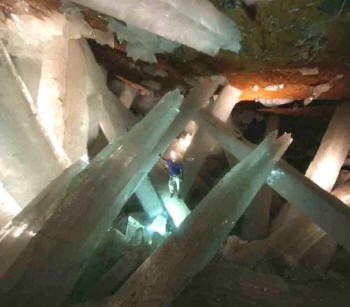 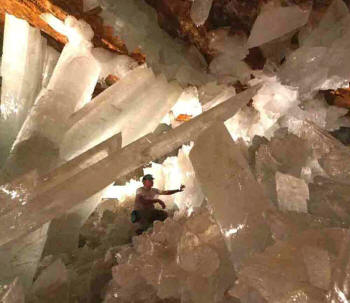
Back to Contents
Cristales Gigantes de
Selenita
del Sitio Web
MineralTown
Cuevas de cristal de Naica
Profundamente debajo de la superficie de un aislado sistema
montañoso en Méjico descansan dos espacios de esplendor: los
cristales translúcidos de longitud y circunferencia como árboles de
pino adultos descansan echados uno encima de otro, como si los rayos
de luna tomaron repentinamente peso y sustancia.
 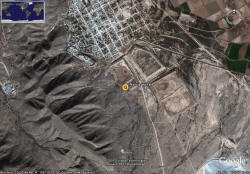
En abril de 2000,
los hermanos Eloy y Javier Delgado encontraron lo qué los expertos
creen que son los cristales aislados más grandes del mundo mientras
que abrían un nuevo profundo túnel de exploración en la mina de
plata, plomo y zinc de Naica de la meridional Chihuahua.
Después de
descubrir una pequeña abertura cerca de 300 metros más abajo, Eloy
se retorció adentro y encontró una caverna de 8 metros llena de
cristales inmensos. Un mes y medio después, otro equipo de mineros
de Naica les sucedió lo mismo con una caverna adyacente incluso más
grande que la primera.

Los geólogos conjeturan que un compartimiento de magma, o roca
fundida sobrecalentada, que se encontraba a dos o tres millas por
debajo de la montaña forzó los líquidos ricos en minerales hacia
arriba a través de una grieta en las aberturas en la roca de fondo
de piedra caliza cerca de la superficie. Durante tiempo, quizá más
de 30 millones de años, este líquido hidrotérmico depositó los
sulfuros ricos en plata, plomo y zinc en la roca de fondo de la
piedra caliza.
Estos metales se han minado aquí desde que los prospectores descubrieron los depósitos en 1794 en un pequeño
sistema de colinas al sur de la ciudad de Chihuahua. Además, los
líquidos hidrotérmicos disolvieron el yeso, el mismo material usado
en cartón de yeso y el yeso de París, situado en la roca de fondo.
Las soluciones calientes, ricas en mineral dieron a luz a estos
cristales gigantes de selenita.
Además de columnas de 1 metro de diámetro y 15 metros en longitud, la
caverna contiene fila sobre fila de formaciones diente de tiburón de
hasta 1 metro de alto, que se colocan en los ángulos impares a
través de la cueva. Hasta abril de 2000, los funcionarios que
minaban habían restringido la exploración en un lado de la grieta
fuera de la preocupación que cualquier nuevo túnel pudo conducir a
inundar el resto de la mina. Solamente después que el nivel del agua
había caído suficientemente autorizaron el túnel que condujo a los
hermanos Sanchez al asombroso descubrimiento.
Previamente, los ejemplos más grandes del mundo de cristales de
selenita vinieron de una caverna próxima descubierta en 1910 dentro
del mismo complejo de la cueva de Naica. Varios ejemplos de la Cueva
de las Espadas se exhiben en el Janet Annenberg Hooker Hall of
Geology, Gems, and Minerals del Smithsonian's National Museum of
Natural History.
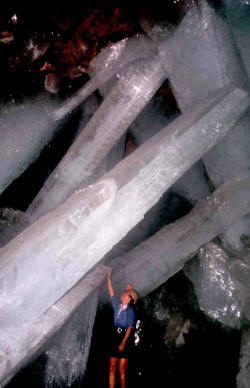
Cristales gigantes de yeso en la mina Naica, Méjico
Algunos hechos y datos adicionales:
-
El tamaño de la cueva es de casi 50m de largo por 30m de ancho. La
cueva incluye cristales 1.5 m de alto con lados agudos, y cristales
más grandes son como vigas más de 12m largo y 0.60m de grueso.
-
Los hombres que descubrieron la cueva fueron los hermanos Eloy y
Javier Delgado
-
La primera cueva descubierta fue llamada Ojo de la reina, porque
tiene una pequeña entrada, y se parece a un ojo humano. La primera
cueva original es de 20m en longitud por un promedio de 10m ancho.
Esta cueva no está todavía abierta al público.
-
Para que los cristales se formen, deben tener dos condiciones
principales - primero la formación de la cueva, y entonces la
formación de los cristales.
-
La formación de la cueva se relaciona con la circulación del agua
subterránea a lo largo del sistema de grietas o de la fractura que
disuelve el carbonato de calcio de la piedra caliza, y va creando
una cueva.
-
El proceso de la formación de los cristales es más complicado porque
depende de la temperatura, la presión, la geoquímica y la
fluctuación del acuífero dentro de la cueva. El agua termal, rica en
ácido sulfúrico por la acción entre el agua y la oxidación del plomo
y del sulfuro del zinc, asciende a través de las fracturas y
consigue el carbonato por la disolución de la piedra caliza. Sobre
la sobresaturación que alcanza la precipitación y la cristalización
del sulfato de calcio comenzadas. Pensamos que el crecimiento de los
cristales tomó más de 30 años si no había un cambio en las
condiciones de la cueva.
-
La exploración se está avanzando al lado de la grieta, pero estamos
intentando preservar la cueva. Mi opinión personal es que tenemos
más cuevas como esta sin descubrir.
-
Estamos haciendo una investigación conjuntamente con la universidad
de Granada de España y estamos haciendo pruebas de laboratorio con
la UTEP de EL Paso, para intentar explicar la formación de los
cristales.
-
Vamos a hacer un proyecto de ingeniería para mantener las
condiciones originales de la cueva antes de que esté abierta al
público. La mina está en ambos lados de la grieta, pero se protege
el área de la cueva.
-
La cueva no tiene ninguna agua. El agua va abajo a los niveles más
bajos de la mina y se bombea a la superficie. Estamos bombeando
realmente 14.000 galones por minuto de agua caliente (54°C).
-
La cueva está abierta bajo visita restringida para el público, pero
por el momento sólo para científicos, geólogos, mineralogistas o
cualquier persona que tiene interés en la admiración de los
maravillosos cristales sin dañarlos.
Back to Contents
Free
Standing Gypsum Crystals Up to 12 m. Size in the Naica Lead-Zinc
Mine
from
GiantCrystals Website
The Naica mine with its enormous gypsum crystals may well be called
the "Queen of the Giant Crystal localities". Giant crystals in
general are exactly this : of remarkable dimensions ! But they are
not necessarily nice or esthetic in the common sense and in fact
they only rarely display free growing crystals. In Naica they do!
And all what you ever imagined about
giant crystals in the interior of the earth, about enormous bugs
filled with glittering crystals so large, you can walk among them,
comes true in Naica ! This is the place to be for the real giant
crystal enthusiast and quite frankly I would be glad and honored, if
I ever have the opportunity to visit this place.

Historic photo of the
Cave of the Swords in the upper levels of the Naica mine
Photo Source : FOSHAG, W.F. (1927)
Though the Naica mine is no show mine,
but still a working and producing lead - zinc mine owned by the
Penoles Company. Continuous mining goes on since more than a century
and in 1910 the first of several crystal caves was discovered in a
depth of 120 m underground. This so called "Cave of the Swords"
contained extraordinary large sword-like selenite (gypsum) crystals
up to 2 m size.
The cave supplied large quantities of
large scale specimen with magnificent "herring bone structure"
selenite crystals to major mineralogical and collections world wide.
It is a single huge chamber about 70m in diameter and is still
accessible to geoscientists and even - as far as we know - to the
public. A narrow winding path leads to the forest of crystals, which
however have lost much of its luster and splendor over the decades.
In 2000 another crystal cave system was discovered at 300 m depth,
even much more spectacular than the original discovery back in 1910.
This newest discovery was named the "Cave of the Crystals" and it
turned out to be one of the most spectacular geological and
mineralogical discoveries ever made ! In fact it is a complex system
of caves orientated along a geological fault, which yield free
growing gypsum crystals up to 12 m size (!) and 2 m diameter.
As the initial temperature inside the caves was 60°C and the
humidity 100%, a detailed exploration of the caves proved extremely
difficult. There is the story about a mine worker, who tried to
steal some of the magnificent crystals shortly after the initial
discovery, but was overwhelmed by heat, humidity and the low oxygen
content of the cave atmosphere, lost consciousness and was found
literally cooked by his fellows some days later...

Giant gypsum crystals
up to 12 m in the lower levels of Naica mine
That said, conditions in the caves are
much more hospitable now and a lot of photos exist on the web
showing cave explorers posing in T-Shirts within a maze of giant
crystals. But serious exploration and documentation of the caves and
the giant gypsum crystals still has its obstacles. Right now a group
of Italian speleologists - the Laventa group - has started a large
scale scientific mapping project, using state of the art technical
equipment to tackle the still hostile environment of these caves.
Please have a look here for more information of this venture
including an online diary.
The discovery of the giant gypsum crystals at Naica has triggered a
wealth of geological research on this subject with the first papers
published only recently. For more information please visit our
Reading Room.
More scientific literature is likely to
be published within the near future.
|
The Naica gypsum crystals in
a nutshell
|
Mineralogy : |
Gypsum, possibly some
sulfide minerals |
|
Crystal Size : |
mostly freestanding
prismatic crystals up to 12 m |
|
Geology & Origin : |
Possibly hydrothermal
replacement of limestone by sulphuric
acids, more research is certainly
warranted |
|
Current status : |
Active mine,
access to upper crystal caves for
tourists possible, access to lower
crystal caves remain restricted |
|
Remarks : |
Spectacular
freely developed (!) gypsum crystals up
to 12 m, possibly the largest in the
world |
|
|
|
Other notable & famous gypsum
occurences
Note: Gypsum is a
very frequent mineral and even large gypsum
crystals are by no means uncommon. There are
however some outstanding occurrences, namely :
-
Gypsum crystals
of up to 12 m or are rumored to occur at
other Mexican localities such as the Caverna
de Santo Domingo, Santa Eulalia district.
-
Giant clear
gypsum crystals up to 7 m are known from the
Debar gypsum mine
Macedonia.
-
The "Gran Geoda"
of the
Pilar de Jaravia
mine, Spain with large, clear gypsum
crystals.
-
Enormous
crystals of gypsum are reported from the
Braden and the El Teniente Mine,
Chile...possibly even the largest of the
world.
-
Perfect crystals
up to 1 m are known to occur in the Raura
mine, Lima Department, Peru.
|
|
Back to Contents
|











